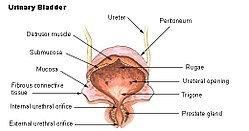Trigone_of_the_urinary_bladder
Trigone of urinary bladder
Triangular region of the internal urinary bladder
The trigone (also known as the vesical trigone)[1] is a smooth triangular region of the internal urinary bladder formed by the two ureteric orifices and the internal urethral meatus.
This article needs additional citations for verification. (November 2016) |
The area is very sensitive to expansion and once stretched to a certain degree, the urinary bladder signals the brain of its need to empty. The signals become stronger as the bladder continues to fill.
Embryologically, the trigone of the bladder is derived from the caudal end of mesonephric ducts, which is of mesodermal origin (the rest of the bladder is endodermal). In the female the mesonephric ducts regress, causing the trigone to be less prominent, but still present.

